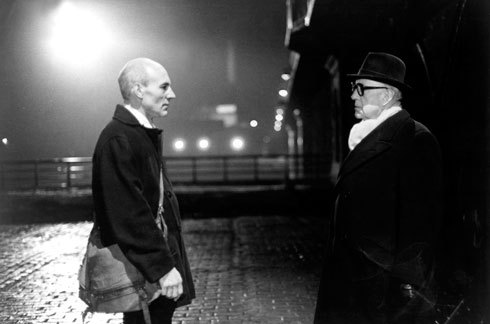the ghosts were howling in the late afternoon
we were singing along to the same old tune
Alongside Mage: the Ascension, the other White Wolf game I keep revisiting my purely hypothetical plans for is Vampire: the Requiem.
Unlike the my dissatisfaction with the Ascension to Awakening transition, I think Vampire really benefits from the local, ground-level focus Requiem brought. The limits on cosmological buy-in and supernatural history don't just give you greater mechanical freedom in building your own little corner of vampiredom, it ends up foregrounding your world-building decisions on the street level. The first questions you ask aren't how the local Sabbat relates to Montreal or Mexico City, or whether the Tzimisce elder has a pew reserved in the Cathedral of Flesh, but whether your city even has a prince or not… or even other vampires. It's a different kind of game when biggest monsters on the block are your player characters.
As much as I like it, though, that doesn't stop me from wanting to mess with it even more:
• No Clans: Vampires are vampires. There is no global culture of vampirism which gives names to different lineages, and no recognition of a broader vampiric genealogy beyond the immediate sire-to-spawn relationship… if that's even there.
Bloodlines exist as very specific permutations of vampirism, whatever vampirism is.
Mechanically speaking, this means that new characters may purchase Disciplines from the following list as 'in-clan' Disciplines: Celerity, Resilience and Vigor.
The rest of the regular Disciplines may only be taken, at the cost of an out-of-clan Discipline, if they're 'unlocked' by choosing one of three clan weaknesses some time before Blood Potency 3. This represents a 'transitional period' between vampires who are just physically more powerful than humans and becoming weirder, more alien creatures of the night.
When the weakness is chosen, one of the previous Disciplines at a rating of one or zero dots may be un-selected as an 'in-clan' discipline, and an 'unlocked' Discipline selected as 'in-clan' in its place.
Mekhet weakness: Auspex, Obfuscate, Majesty
Nosferatu weakness: Animalism, Nightmare, Obfuscate
Ventrue weakness: Animalism, Dominate, Majesty
• Don't Scare The Rubes: You will note the lack of Protean on the above list of Disciplines. Aside from the Nosferatu weakness, and the potential for blood magic, there's no really outré Vampire powers on the table for young vampires.
• No Covenants… Well, Except For These Guys: The Ordo Dracul works well as a multinational, long-term conspiracy because it has a job to do and the indoctrination framework to perpetuate itself. Likewise, the idea of a secret vampire religion, passed down through the ages as an addendum to the faith they professed as a mortal makes sense due to mirroring the parasitic nature of the vampire itself. As the vampire is a tick on the hide of human culture, so is its vampirism-warped culture.
So the Order exists in a more-or-less similar form, and the Lancea Sanctum and the Circle of the Crone are there as amorphous themes for local iterations, some of which might even use covenant terminology. The Invictus and the Carthians, however, are absent.
That doesn't mean that Invictus and Carthian behaviour isn't there, though. Thematically, the two poles provide the Gothic (as in, feudal) and Punk (as in, anarchist) halves of the vampire equations. Practically, any region which has a vampire population large enough to have a Prince, Alpha or Boss also has enough vampires to look for alternative ways of divvying the blood up.
Mechanically, this all means that Covenant affiliation and the mechanical benefits of such are only available to vampires in large cities, unless a smaller city or town has a secret cult of vampires dedicated to perpetuating the secrets of vampire-specific knowledge (like Cruac, Theban Sorcery, the Coils, or a particular weird discipline/rite).
• Vampirism is Weird: This is where bloodlines come in. Vampires, as they get older, get weirder, so there's bloodlines running around doing weird bloodline things. The rules aren't any different, except that the prerequisite clan is changed to dots in the clan's primary discipline (except for Protean, which is replaced with Animalism, making Gangrel bloodlines a little more broadly available). Anything that has Protean-like transformations are out, though.
Also, many of the extreme versions of clan powers and weaknesses available in the clan books are present, especially Nosferatu blossoming flaws and Necropoli, the Malkavia virus, Hollow embraces and Mekhet shadow cults.
• Stuff is Weird: Vampires share the world with psychics and mortal sorcerors, as well as monsters from Predators and Antagonists, like funky Azlu/Beshilu/vampire hybrids, zombies, imbued, the Thief, the Hunger, and whatever crazy weirdness I think is cool. I'm not sure if I want supernatural societies out there, as opposed to just things, but I'm not totally opposed to a small conspiracy or two if it seems fun.
• Maybe Martin: I'm drawn to giving every vampire who doesn't take the Nosferatu weakness the No Fangs flaw. That, more than anything else, should give the campaign a unique feel. It forces the players to make a very literal decision to embrace monstrosity or find a workaround that keeps them 'human.'
I turned to my brothers
to look them in the eyes
there was ash
ash falling from the sky




